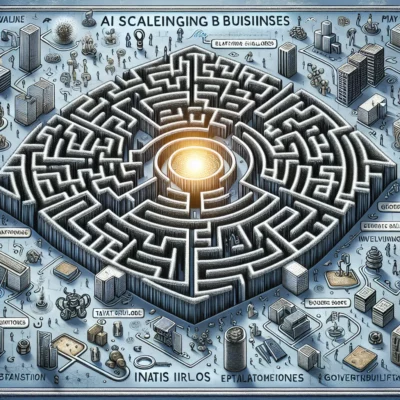Artificial Intelligence (AI) is no longer a futuristic concept. It is here, transforming industries and redefining business landscapes. Yet, for large enterprises, scaling AI initiatives remains a complex puzzle. This blog delves into the intricacies of AI scaling in enterprises, exploring the challenges, strategies, and the road ahead.
Understanding the Landscape of AI in Enterprises
The adoption of AI in large organizations is on a steady rise. Companies are increasingly recognizing the transformative potential of AI to enhance efficiency, drive innovation, and create competitive advantages. However, scaling AI initiatives is not just about implementing technology; it’s about achieving strategic goals such as improving customer experiences, optimizing operations, and driving revenue growth.
Potential Benefits of Scaling AI Initiatives
- Enhanced Decision-Making: AI can process vast amounts of data quickly, providing insights that aid in better decision-making.
- Operational Efficiency: Automation of routine tasks can lead to significant time and cost savings.
- Customer Experience: Personalized services powered by AI can improve customer satisfaction and loyalty.
- Innovation and Growth: AI can open up new business models and revenue streams.
Identifying Key Challenges in Scaling AI
Despite the promising benefits, scaling AI in enterprises is fraught with challenges. Below are some critical hurdles organizations face:
Data Management and Quality
Data is the backbone of AI. However, ensuring data quality and accessibility is a significant challenge. Many organizations struggle with data silos, where data is isolated within different departments, making integration difficult. Robust data governance frameworks are essential to manage data effectively and ensure its quality, consistency, and security.
Talent and Skill Gaps
There’s a notable shortage of skilled AI professionals. To bridge this gap, organizations need to invest in continuous training and upskilling of existing staff. Strategies for attracting and retaining AI talent include competitive compensation, creating a stimulating work environment, and fostering a culture of learning and innovation.
Organizational Culture and Change Management
Resistance to change is a common barrier in large organizations. Fostering a culture of innovation is crucial for successful AI scaling. This involves effective change management strategies, including clear communication, stakeholder engagement, and demonstrating the value of AI initiatives.
Infrastructure and Technology Integration
Integrating AI with existing IT infrastructure can be challenging. Organizations need scalable and flexible technology solutions to support AI initiatives. Cloud computing and edge technologies play a vital role in providing the necessary infrastructure to handle AI workloads efficiently.
Ethical and Regulatory Considerations
AI deployment comes with ethical implications, such as bias and privacy concerns. Compliance with regulatory standards is critical to avoid legal repercussions. Transparent and fair AI practices are essential to maintain trust and integrity in AI systems.
Strategies for Overcoming Challenges
To navigate the AI scaling maze, organizations can adopt the following strategies:
Building a Strong AI Strategy
Aligning AI initiatives with business objectives is crucial. A clear roadmap and vision for AI deployment, driven by leadership, can guide organizations in their AI journey. This involves setting realistic goals, measuring progress, and adapting strategies as needed.
Fostering Collaboration and Partnerships
Collaborating with external partners and vendors can provide access to expertise and resources that may not be available internally. Successful case studies show that partnerships can accelerate AI scaling. Industry consortia and alliances can also facilitate knowledge sharing and innovation.
Leveraging Emerging Technologies
Emerging technologies like AI automation tools and machine learning platforms can simplify AI deployment. These tools help organizations manage AI workloads more efficiently and focus on strategic initiatives. Advancements in AI research continue to provide new opportunities for scaling efforts.
The Road Ahead for AI in Large Organizations
As we look to the future, the role of AI in large organizations will only grow. Key takeaways from this discussion highlight the importance of strategic alignment, overcoming challenges, and leveraging partnerships and technology. Future trends in AI scaling include increased automation, enhanced human-AI collaboration, and the continued evolution of AI technologies.
Organizations that embrace AI as a strategic enabler for growth are poised to lead in the digital age. By navigating the AI scaling maze with a clear strategy and collaborative approach, enterprises can unlock the full potential of AI and drive sustainable growth.
